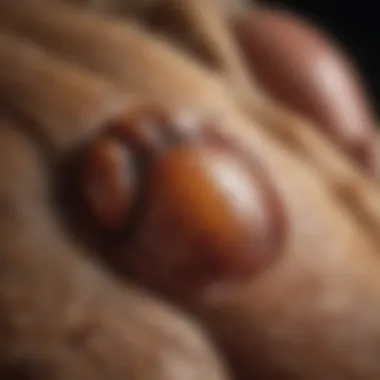Unveiling the Perils of Tick Infestations on Canine Companions


Animal Species Profile
As we embark on exploring the hazards posed by tick infestations on our beloved canine companions, it is vital to understand the nature of dogs. Dogs, scientifically known as Canis lupus familiaris, are descendants of wolves and exhibit a diverse range of physical characteristics and appearances based on their breed. From the majestic Great Dane to the tiny Chihuahua, dogs showcase a wide array of sizes, coat types, and colors. They originate from various regions globally, leading to diverse natural habitats and distributions. While some thrive in cold climates, others prefer warmer environments. In terms of behavior, dogs are social animals, relying heavily on their pack mentality. They form strong bonds with their human families and other pets, emphasizing their need for social interactions and companionship.
Introduction
Ticks infestations can pose a significant threat to the health and well-being of dogs, making it imperative for pet owners to be vigilant and proactive. These tiny parasites latch onto the dog's skin, potentially transmitting dangerous diseases and causing various health complications. Understanding the nuances of tick infestations is crucial in safeguarding your furry companion from harm. This section aims to delve into the intricacies of tick infestations on dogs, shedding light on the implications, prevention strategies, and treatment options that are essential for every responsible pet owner.
Understanding Tick Infestations
As we explore the realm of tick infestations on dogs, it becomes evident that these parasitic arachnids can wreak havoc on a canine's health. Ticks are not merely nuisances but carriers of diseases that can have grave consequences. By burrowing into the dog's skin to feed on blood, ticks pose a dual threat - causing discomfort and potentially transmitting illnesses. It is essential to grasp the lifecycle of ticks, their preferred habitats, and the signs indicating a tick infestation on your furry friend. Being equipped with this knowledge empowers pet owners to take swift and effective action to protect their dogs.
Implications of Tick Bites on Dogs
Tick infestations pose significant risks to dogs, impacting not only their physical health but also their overall well-being. The presence of ticks can lead to various health issues and discomfort for our furry companions, highlighting the critical importance of addressing this issue promptly and effectively. By understanding the implications of tick bites on dogs, pet owners can take necessary precautions to protect their pets from potential harm, ensuring their longevity and quality of life.
Health Risks Associated with Tick Infestations
Potential transmission of diseases
One of the most alarming aspects of tick infestations on dogs is the potential transmission of diseases. Ticks act as vectors for various pathogens, including bacteria, viruses, and parasites, which can be transferred to dogs during a bite. This transmission can result in severe illnesses such as Lyme disease, Ehrlichiosis, and Anaplasmosis, posing a significant threat to the dog's health and requiring immediate medical attention.
Allergic reactions to tick saliva
Another distressing consequence of tick infestations is allergic reactions to tick saliva. Some dogs may exhibit hypersensitivity to components in tick saliva, leading to inflammatory responses and allergic symptoms upon exposure. Itching, redness, and skin rashes are common manifestations of this allergic reaction, causing discomfort and deteriorating the dog's skin health if left untreated.
Anemia and skin irritation
Ticks feeding on a dog's blood can result in anemia and skin irritation, further exacerbating the negative impact of infestation. Anemia, caused by blood loss through tick feeding, can lead to weakness, lethargy, and pale mucous membranes in dogs. Additionally, the persistent presence of ticks on the skin can cause local irritation, redness, and hair loss, creating a distressing and uncomfortable experience for the affected dog.


Impact on a Dog's Paw
Pain and discomfort
Tick infestations can cause substantial pain and discomfort, especially when ticks embed themselves in a dog's paw pads or between toes. The continuous irritation and inflammation from tick bites can result in lameness, limping, and evident signs of distress in the affected paw. Addressing this pain is crucial to prevent further physical and psychological distress for the dog.
Risk of infection
Apart from immediate discomfort, the risk of infection is a prevalent concern with tick infestations on a dog's paw. Ticks carry pathogens that can lead to secondary infections at the bite site or in surrounding tissues, complicating the dog's recovery process and necessitating prompt veterinary intervention to prevent systemic complications.
Impaired mobility
Tick infestations affecting a dog's paw can significantly impair mobility, restricting normal movement and causing gait abnormalities. Swollen and tender paw pads from tick bites can hinder the dog's ability to walk, run, or engage in regular activities, impacting its quality of life and overall well-being. Ensuring early detection and treatment is essential to restore the dog's mobility and vitality.
Preventing Tick Infestations
The critical focus of this segment centers on the prevention of tick infestations on dogs, a pivotal aspect when considering the overall well-being and health of our furry companions. Tick infestations pose substantial risks to dogs, ranging from potential transmission of diseases to discomfort and irritation. Thus, understanding and implementing robust preventative measures is paramount to ensure the safety and health of our pets.
Regular Inspection and Grooming
Checking for ticks after outdoor activities
In the realm of tick prevention, checking for ticks after outdoor activities emerges as a fundamental practice. Regularly inspecting your dog's fur and skin post-outdoor excursions allows for the timely detection and removal of any lurking ticks. This meticulous examination helps eliminate potential infestations before they escalate, safeguarding your pet's health and well-being. By diligently conducting these checks, pet owners can stay proactive in combating tick-related risks, promoting a safe environment for their beloved canine companions.
Keeping the dog's fur trimmed and clean
Maintaining a trimmed and clean fur coat for your dog is a significant contributor to tick prevention. Ticks often hide in dense or unkempt fur, making regular grooming an essential preventative measure. Trimming the fur not only enhances visibility during tick inspections but also minimizes the chances of ticks finding a suitable hiding spot. Additionally, clean fur is less attractive to ticks, reducing the likelihood of infestations. This grooming practice not only improves the aesthetic appeal of your pet but also plays a pivotal role in mitigating tick-related health risks.
Use of Preventive Treatments


Topical medications
Topical medications stand as a cornerstone in the arsenal against tick infestations. These treatments offer a layer of defense, repelling ticks and other parasites from latching onto your dog's skin. The key advantage of topical medications lies in their ease of application and targeted efficacy. By directly applying these treatments to your pet's skin, you create a barrier that deters ticks, safeguarding your dog from potential infestations.
Oral preventatives recommended by veterinarians
For a comprehensive approach to tick prevention, oral preventatives recommended by veterinarians play a crucial role. These medications provide systemic protection, targeting ticks from within your dog's system. By administering these oral preventatives as prescribed, pet owners can proactively combat tick infestations from the inside out. Moreover, vet-recommended oral preventatives offer a reliable and convenient method to ensure continuous protection against these pesky parasites.
Creating a Tick-Free Environment
Regular yard maintenance
Maintaining a tick-free environment begins with regular yard upkeep. By keeping your outdoor space well-maintained, you minimize the habitats conducive to tick infestations. Removing debris, trimming shrubs, and mowing the lawn regularly not only enhances the aesthetic appeal of your yard but also reduces the prevalence of ticks. This proactive approach to yard maintenance creates an inhospitable environment for ticks, decreasing the likelihood of infestations and promoting a safer space for your dog to roam.
Reducing tick habitats
Taking proactive steps to reduce tick habitats further strengthens your defense against infestations. Identify and address areas in your surroundings where ticks commonly reside, such as wooded areas or tall grass. By implementing strategies to reduce these tick-prone zones, such as landscaping modifications or targeted treatments, you create a less hospitable environment for ticks to thrive. This careful intervention helps fortify your overall tick prevention efforts, enhancing the safety and well-being of your canine companion.
Detecting and Removing Ticks
In the thorough examination of the dangers posed by tick infestations on dogs, a pivotal focus lies on the meticulous process of detecting and removing these parasites. The significance of this topic within the article transcends simple awareness; it serves as a fundamental pillar in maintaining a dog's health and well-being. By delving into the specific elements of detecting and removing ticks, dog owners gain essential insights into safeguarding their pets from potential health risks. One cannot understate the importance of timely detection and proper removal techniques in combating the adverse effects of tick infestations.
Identifying Tick Infestations
Recognizing common symptoms
When discussing the identification of tick infestations, the spotlight turns towards recognizing common symptoms. This aspect plays a crucial role in the overall objective of the article by enabling dog owners to swiftly identify signs of a potential infestation. By shedding light on the key characteristic of recognizing common symptoms, this article aims to equip readers with actionable knowledge to detect tick presence at an early stage. The uniqueness of this approach lies in its practicality and effectiveness, making it a preferred choice for dog owners concerned about their pets' well-being.
Examining the dog thoroughly for ticks


A complementary aspect of detecting tick infestations involves thoroughly examining the dog for ticks. This proactive step significantly contributes to the overarching goal of protecting dogs from the implications of tick bites. Emphasizing the importance of this step and highlighting its key characteristic - thoroughness - underscores its significance in this article. The distinctive feature of meticulously examining the dog for ticks lies in its ability to catch any hidden parasites, offering a comprehensive approach to tick prevention and control.
Safe Tick Removal Techniques
Using fine-tipped tweezers
Turning to the safe removal of ticks, employing fine-tipped tweezers emerges as a critical technique in this delicate process. The key characteristic of using fine-tipped tweezers lies in its precision, allowing dog owners to grasp the ticks firmly without causing harm to the pet. This method stands out as a preferred choice in the context of this article due to its efficacy and safety. The unique feature of fine-tipped tweezers is their ability to grasp even the smallest ticks, ensuring thorough removal and reducing the risk of complications.
Avoiding squeezing the tick's body
Another vital technique in safe tick removal is avoiding squeezing the tick's body. By elucidating the key characteristic of this approach - gentleness - this article emphasizes the importance of minimizing direct contact with the tick. This prudent advice serves as a cornerstone in tick removal strategies outlined here, emphasizing the significance of caution. The unique feature of avoiding squeezing the tick's body is its adherence to safety protocols, reducing the risk of transmitting harmful substances and minimizing potential skin irritation.
Consulting a Veterinarian
When it comes to ensuring the optimal health and well-being of your furry companion, consulting a veterinarian emerges as a crucial step in the process. Especially in the context of tick infestations on dogs, seeking professional guidance from a vet plays a pivotal role in mitigating risks and addressing potential health concerns effectively and comprehensively. By consulting a veterinarian, dog owners gain access to expert knowledge, personalized recommendations, and tailored treatment plans that are essential for combating tick-borne diseases and safeguarding their pet's health.
Seeking Professional Guidance
Consulting a vet for proper diagnosis and treatment
Consulting a veterinarian for proper diagnosis and treatment is a cornerstone of managing tick infestations on dogs. This aspect of veterinary care involves a comprehensive assessment of the dog's health status, tick exposure, and any existing symptoms or concerns. Veterinarians possess the expertise to accurately identify tick-related issues, prescribe appropriate medications, and administer targeted treatments to alleviate discomfort and eradicate tick infestations effectively. The precision and thoroughness of a vet's diagnosis not only ensure the prompt resolution of specific health problems but also contribute to the overall well-being and longevity of the animal. Opting for veterinary consultation ensures that dog owners receive reliable guidance and support in handling tick-related challenges, emphasizing proactive care and preventive measures.
Discussing tick prevention strategies
Engaging in discussions regarding tick prevention strategies with a veterinarian holds significant relevance in the context of dog health management. This proactive approach enables pet owners to stay informed about the latest advancements in tick control, understand risk factors associated with tick exposure, and implement tailored prevention plans tailored to their pet's specific needs. By collaborating with a veterinarian on tick prevention strategies, dog owners can create a comprehensive defense mechanism against tick infestations, focusing on techniques such as topical preventatives, environmental modifications, and regular screenings. The interactive dialogue with a vet regarding tick prevention empowers pet owners to make informed decisions, implement proactive measures, and establish a sustainable framework for long-term tick management. Ultimately, discussing prevention strategies with a veterinarian cultivates a proactive and vigilant approach to protecting dogs from the dangers of tick infestations.
Conclusion
Ensuring Your Dog's Health and Safety
When it comes to securing the health and safety of our furry friends in the face of tick infestations, a multifaceted approach is paramount. Monitoring your dog's well-being closely, especially after outdoor expeditions, is essential to early detection and mitigation of any potential risks associated with ticks. Regular grooming and inspection routines play a pivotal role in identifying and addressing infestations promptly. Ensuring that your dog's living environment remains tick-free through meticulous yard maintenance and habitat reduction further fortifies their defenses against these unwelcome intruders.
Implementing preventive treatments as recommended by veterinarians, whether through topical medications or oral preventatives, serves as a proactive shield against future infestations. In cases where tick bites do occur, swift and safe removal techniques using fine-tipped tweezers are crucial to minimizing the risk of complications or infections. However, always exercise caution to avoid squeezing the tick's body during removal, as this could inadvertently increase the likelihood of disease transmission or skin irritation.
Seeking professional guidance from a veterinarian is paramount in situations where tick infestation or related health issues arise. Consulting a vet for accurate diagnosis, tailored treatment plans, and expert advice on effective tick prevention strategies is instrumental in maintaining your dog's optimal health and well-being. By fostering a collaborative relationship with veterinary professionals, dog owners can access the expertise and support needed to navigate the complexities of tick management successfully.







